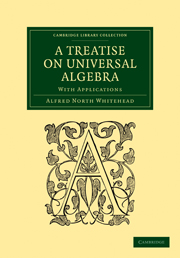Book contents
- Frontmatter
- PREFACE
- Contents
- BOOK I PRINCIPLES OF ALGEBRAIC SYMBOLISM
- BOOK II THE ALGEBRA OF SYMBOLIC LOGIC
- BOOK III POSITIONAL MANIFOLDS
- BOOK IV CALCULUS OF EXTENSION
- CHAPTER I COMBINATORIAL MULTIPLICATION
- CHAPTER II REGRESSIVE MULTIPLICATION
- CHAPTER III SUPPLEMENTS
- CHAPTER IV DESCRIPTIVE GEOMETRY
- CHAPTER V DESCRIPTIVE GEOMETRY OF CONICS AND CUBICS
- CHAPTER VI MATRICES
- BOOK V EXTENSIVE MANIFOLDS OF THREE DIMENSIONS
- BOOK VI THEORY OF METRICS
- BOOK VII APPLICATION OF THE CALCULUS OF EXTENSION TO GEOMETRY
- Index
CHAPTER II - REGRESSIVE MULTIPLICATION
Published online by Cambridge University Press: 29 August 2010
- Frontmatter
- PREFACE
- Contents
- BOOK I PRINCIPLES OF ALGEBRAIC SYMBOLISM
- BOOK II THE ALGEBRA OF SYMBOLIC LOGIC
- BOOK III POSITIONAL MANIFOLDS
- BOOK IV CALCULUS OF EXTENSION
- CHAPTER I COMBINATORIAL MULTIPLICATION
- CHAPTER II REGRESSIVE MULTIPLICATION
- CHAPTER III SUPPLEMENTS
- CHAPTER IV DESCRIPTIVE GEOMETRY
- CHAPTER V DESCRIPTIVE GEOMETRY OF CONICS AND CUBICS
- CHAPTER VI MATRICES
- BOOK V EXTENSIVE MANIFOLDS OF THREE DIMENSIONS
- BOOK VI THEORY OF METRICS
- BOOK VII APPLICATION OF THE CALCULUS OF EXTENSION TO GEOMETRY
- Index
Summary
Progressive And Regressive Multiplication. (1) According to the laws of combinatorial multiplication just explained the product of two extensive magnitudes Sρ and Sσ respectively of the ρth and σth order must necessarily be null, if ρ + σ be greater than ν, where the original manifold is of ν - 1 dimensions. Such products can therefore never occur, since every term of any equation involving them would necessarily be null.
In the case ρ + σ > ν we are accordingly at liberty to assign a fresh law of multiplication to be denoted by the symbol SρSσ. Let multiplication according to this new law (to be defined in § 100) be termed ‘regressive,’ and in contradistinction let combinatorial multiplication be called progressive.
Thus if ρ + σ < ν, the product SρSσ is formed according to the progressive law already explained. Such products will be called progressive products. If ρ + σ > ν the product SρSσ will be formed according to the regressive law. Such products will be called regressive products. If ρ + σ = ν, the product SρSσ may be conceived indifferently as formed according to the progressive or regressive law.
(2) In this last case it is to be noted that SρSσ, must necessarily be of the form α(e1e2 … eν), where e1e2 … eν are ν independent reference elements of the original manifold.
- Type
- Chapter
- Information
- A Treatise on Universal AlgebraWith Applications, pp. 181 - 198Publisher: Cambridge University PressPrint publication year: 2009First published in: 1898



